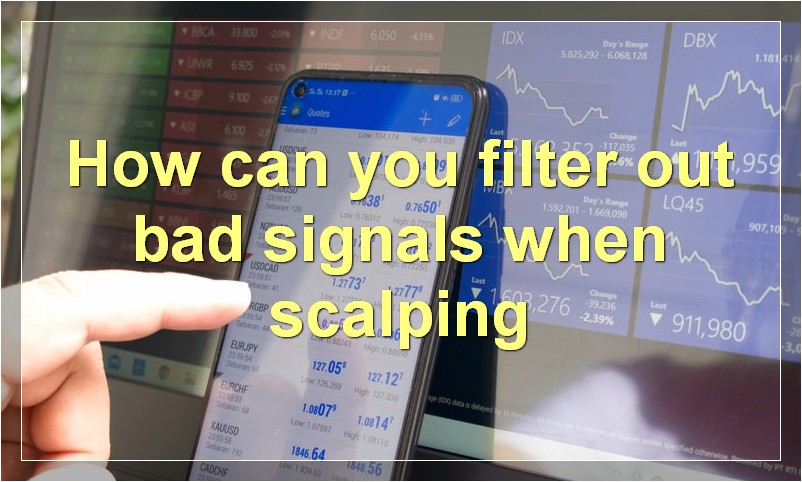Are you looking to make some quick and easy money? If so, then scalping might be the perfect trading strategy for you!
What is a scalping strategy
When it comes to online trading, there are many different strategies that can be used in order to make a profit. One such strategy is known as scalping. Scalping is a type of short-term trading that typically involves taking quick profits on small price movements.
While scalping can be a profitable strategy, it does come with some risks. For one, because scalpers are looking for small price movements, they can often get caught in choppy markets and end up losing money. Additionally, because they are holding their positions for such a short period of time, they can also be subject to slippage (when prices move against them before they can exit their trade).
Despite the risks, scalping can be a viable strategy for those who are willing to take on the risk in order to potentially make quick profits. If you’re thinking of trying your hand at scalping, be sure to do your homework first and practice with a demo account before putting any real money on the line.
What are some common scalping techniques

Scalping is a trading technique that involves making small, frequent profits in order to take advantage of slight price changes. Some common scalping techniques include:
1. Identifying support and resistance levels: Support and resistance levels are key areas where prices are likely to stall or reverse. By identifying these levels, scalpers can enter and exit trades accordingly.
2. Using technical indicators: Technical indicators can help identify potential trade opportunities. Popular indicators used by scalpers include moving averages, Bollinger Bands, and MACD.
3. Managing risk: Risk management is essential when scalping as small price movements can quickly lead to losses. Scalpers typically use stop-loss orders to limit their downside risk.
4. Having discipline: Discipline is needed to stick to a scalping strategy despite experiencing losses. This often requires maintaining a strict trading plan and staying disciplined with risk management.
How do you choose the right scalping strategy for your trading style
When choosing a scalping strategy, the first step is to identify your trading style. Are you more comfortable with a longer-term approach or do you prefer making quick trades?
If you are comfortable with a longer-term approach, you may want to consider a trend-following scalping strategy. This type of strategy involves looking for market trends and trying to capitalize on them.
If you prefer making quick trades, you may want to consider a momentum-based scalping strategy. This type of strategy involves taking advantage of short-term price movements.
Once you have identified your trading style, you can start looking at different scalping strategies and see which one best fits your needs. There is no “perfect” scalping strategy, so it is important to find one that works well for you and your trading style.
What are the benefits and risks of scalping
Scalping is the act of buying and selling a security within the same day. Many traders believe that scalping can lead to quick and profitable trades. However, there are also some risks associated with scalping. Let’s take a look at the benefits and risks of scalping so you can decide if this trading strategy is right for you.
Benefits of Scalping:
1. Scalping can lead to quick and profitable trades.
2. Scalpers typically have a very low risk tolerance, which means they are willing to take small losses in order to make a quick profit.
3. Scalpers usually trade with a large amount of capital, which gives them the ability to make big profits.
Risks of Scalping:
1. Scalping can be very stressful because it requires traders to be constantly monitoring the market for opportunities.
2. Scalpers usually have very tight stop-losses, which means they can get stopped out of their positions frequently.
3. Some brokers may not allow scalping on their platform, so it’s important to check with your broker before you start scalping.
What timeframes are best suited for scalping
The best timeframes for scalping are typically the 1-minute and 5-minute charts. These timeframes allow traders to take advantage of small price movements that occur throughout the day. Scalpers typically look for a large number of small profits, rather than a few large ones. This strategy can be profitable if done correctly, but it requires a great deal of focus and discipline.
How can you filter out bad signals when scalping

When scalping, it is important to be able to filter out bad signals in order to avoid making losing trades. There are a few ways to do this:
1. One way is to use a technical indicator like the RSI or stochastic oscillator to help you identify overbought or oversold conditions. If the market is overbought, this means that there is a higher chance of a price reversal and you should look for shorting opportunities. Similarly, if the market is oversold, this means that prices are more likely to bounce back up so you should look for long entries.
2. Another way to filter out bad signals is by using price action analysis. This involves looking at things like support and resistance levels, trendlines, and candlestick patterns. By understanding how these technical concepts work, you can better identify when a trade is likely to move in your favor or against you.
3. Finally, another way to avoid bad signals is by using risk management techniques. This means setting stop losses and taking profits at predetermined levels so that you don’t get caught in a losing trade. By managing your risk properly, you can protect your capital even if a trade doesn’t go your way.
By using these three methods, you can filter out bad signals and improve your chances of making winning trades when scalping the markets.
What are some common mistakes made by scalp traders
There are a few common mistakes made by scalp traders. One is overtrading. This occurs when a trader takes too many trades in a day, trying to eke out small profits on each trade. This can lead to big losses if the market goes against the trader. Another mistake is not using stop-losses. A stop-loss is an order to sell a security when it reaches a certain price, and it can help limit losses. Finally, some scalp traders don’t use proper risk management, meaning they don’t limit their overall exposure to the market. This can lead to ruin if the markets move against them.
How do you manage your risk when scalping
When scalping, risk management is key. Here are a few tips on how to manage your risk when scalping:
1. Use stop-loss orders: A stop-loss order is an order that you place with your broker to sell a security when it reaches a certain price. This price is typically below the current market price, and it acts as a limit on your losses. By using a stop-loss order, you can limit your losses if the market moves against you.
2. Use take-profit orders: A take-profit order is an order that you place with your broker to buy a security when it reaches a certain price. This price is typically above the current market price, and it acts as a limit on your profits. By using a take-profit order, you can lock in your profits if the market moves in your favor.
3. Use trailing stop orders: A trailing stop order is an order that you place with your broker to sell a security if it starts to fall in price. The “trailing” part of the name comes from the fact that the stop price “trails” the current market price by a certain amount. For example, if you place a trailing stop order for a stock that’s currently trading at $50 per share, with a trailing stop of $5, then your order will become a market order to sell the stock if it falls to $45 per share. Trailing stop orders can help you limit your losses if the market turns against you.
4. Manage your position size: Position size is the number of shares or contracts that you trade. When scalping, it’s important to keep your position size small relative to the overall size of the market. This way, even if the market moves against you, your losses will be limited.
5. Have a plan: Before you enter any trade, it’s important to have a plan. Know what you want to achieve and what you’re willing to risk. Once you have a plan, stick to it!
By following these tips, you can help manage your risk when scalping.
What are some tips for becoming a successful scalper
There is no one-size-fits-all answer to this question, as the best scalping tips will vary depending on the individual trader’s goals, risk tolerance, and market conditions. However, there are some general principles that all successful scalpers share.
First and foremost, a successful scalper must have a clear understanding of what they are trying to achieve. Scalping is a high-frequency trading strategy that seeks to profit from small price movements in a short period of time. As such, it is important to have realistic expectations when scalping, and to focus on making small but consistent profits rather than shooting for the moon.
Second, a successful scalper must be able to control their emotions. Scalping can be an emotionally-charged activity, as small losses can quickly add up. It is important to keep a cool head and stick to your game plan even when things are going against you.
Finally, a successful scalper must have a strong technical understanding of the markets they are trading. Scalping is a highly technical activity, and the ability to read charts and identify patterns is essential. There are many different scalping strategies, so it is important to find one that suits your style and then practice it until you have perfected it.
How can you find good trading opportunities when scalping
When scalping, traders look for small price movements that they can exploit for a quick profit. To find good trading opportunities, scalpers need to be able to identify trends and support and resistance levels. They also need to have a sound money management strategy to protect their capital.

